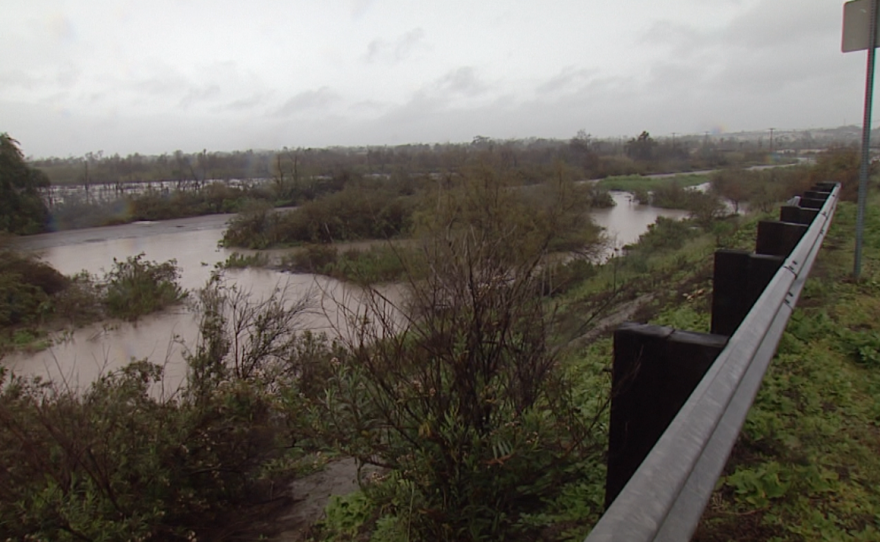Pollution warning signs along San Diego’s South County beaches are just one persistent indicator that raw sewage is an ongoing threat to public health.
Clean water advocates have fought for years to keep cross-border pollution from fouling U.S. waters.
Paloma Aguirre is the coastal and marine director for Wildcoast, an environmental conservation organization. Recently, Aguirre visited Goat Canyon which is just a few hundred yards north of the U.S.-Mexico border. This area is one of five places where sewage-tainted water from Mexico flows into the United States.
“It’s catastrophic. For anyone who doesn’t know this area, or this issue, it is very simple. It’s one of the biggest environmental disasters that our country suffers. Every single year. And now with climate change forecasting more intense storm events, we’re going to see this problem exacerbated over time,” Aguirre said.

Goat Canyon is actually a success story of sorts. Aguirre is standing beside two large catch basins that keep sediment from swamping wetlands in a nearby state park.
“Whenever it rains, it’s a canyon. It drains. The Los Laureles creeks flow across the border and into this area,” Aguirre said.
There is a pollution collector nearby that routes tainted water flow to the nearby International Wastewater Sewage treatment plant.
That facility was built to help treat cross-border flows during dry weather.
Meanwhile, the catch basins keep sediment out of sensitive habitat just a few hundred yards away. One key feature is a small fence that reaches across the basin.
“These are the only types of trash booms in the entire Tijuana River Valley. They’re highly effective. Especially for high floatables. As you can see there’s a lot of plastic bottles. There’s a lot of foam. And that is because in Mexico and the state of Baja California and in the city of Tijuana they don’t have a formal recycling program,” Aguirre said.
When asked what would happen if the trash booms did not exist here, Aguirre said it would devastate the state park.
“We had a case where there was a construction project in Tijuana and they just cut the hillside there," Aguirre said. "There was no plan for sediment control and all that excess sediment destroyed, I think, it was like 30 or 40 acres of wetland and salt-marsh habitat. So it’s incredibly detrimental to the system. And all this plastic is input into the ocean.
"And marine debris is one of the biggest challenges we will face in the next decade or two. We have studies that overwhelmingly come to consensus that we’ll have more plastic in the ocean than fish by 2050,” she said.
The catch basins and trash booms were put in place by state officials to protect sensitive habitat at Border Field State Park and Aguirre thinks there are lessons here for other locations in the Tijuana River Valley.
Just a short distance to the east, a bridge over Dairy Mart Road separates a wide sweeping valley and more rugged river habitat. This sturdy concrete structure was built after flooding washed out the old bridge in the 1990s.
“This is a point where the river forest, or riparian habitat, begins so a lot of the trash and tires that are carried by the storm flows become trapped in the vegetation. And whatever is not trapped makes its way downstream into the estuary and ultimately into the ocean,” Aguirre said.
On the east side of the bridge, the river valley is open. But this bucolic stretch of land changes dramatically when rain drenches the region.
The small trickle of a river during dry times can become a raging torrent of swirling pollution.

“When there’s a strong storm event this can be completely covered and the river can be flowing at a rate of a billion gallons of water a day most of which is completely sewage-tainted and polluted,” Aguirre said.
Aguirre, an Imperial Beach City Council member, would like to see some of the lessons from Goat Canyon applied here. Catch basins could capture wet weather sewage flows, sediment and trash. That would give the International Wastewater Treatment plant a chance to catch up.
Aguirre said it is clear the Tijuana‘s sewage system frequently falls short.
“There’s a pump station right at the border that is capturing all that flow and sending it south. Preventing that flow from coming across the border. The problem is that pump station breaks down all the time. Because it gets clogged with sediment. Because it gets clogged with trash. So, when that pump station fails and some of those flows could be captured by these sediment basins,” Aguirre said.
U.S. federal officials say a lack of funding keeps them from building that infrastructure, but local critics say there is a lack of will. That’s why Imperial Beach, Chula Vista, the Port of San Diego, the State of California and Surfrider San Diego are suing the federal government.
Those organizations hope the courts compel the International Boundary and Water Commission to stop the cross border sewage flows that pollute U.S waters.







